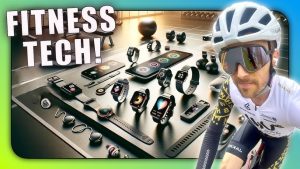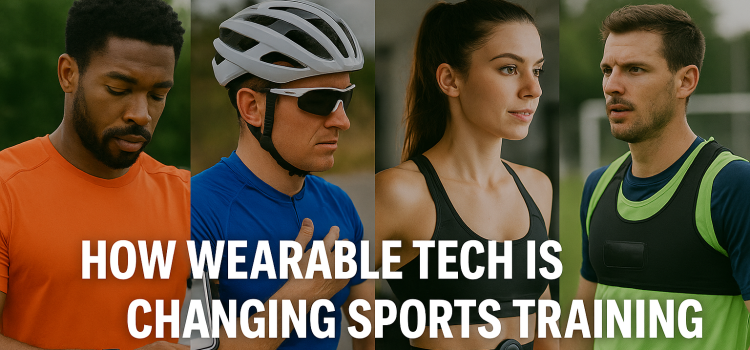
Introduction
Sports training is changing fast because of new wearable gadgets. In 2025, athletes and coaches wear smart devices that tell them what’s happening inside their bodies. These gadgets can show your heart rate, body temperature, how you move, and even how well you sleep. Getting this information right away helps everyone train smarter.
Whether you’re a pro athlete or just love to stay active, wearable health and fitness tech is easy to use and really helpful. In this article, we’ll look at how these wearable computing gadgets are shaking up sports training in 2025 and how they help athletes of all ages perform better and recover faster.
What is Wearable Tech and How Does it Work in Sports?

Wearable tech is small devices you wear, like Smart watches, smart rings (oura ring), smart glasses or bands, that watch how your body moves. They can count your steps, check your blood oxygen levels and blood pressure, monitor your heart rate monitor, track your sleep, and even see how many calories you burn. In 2025, athletes use these gadgets during training to get quick tips on how to do better.
Examples include:
- Smartwatches that show heart rate and distance
- Fitness bands that count steps and sleep
- GPS watches for runners to map their routes
- Heart monitors for cyclists to watch their pulse and activity levels.
All this information helps athletes and coaches make smart training plans, avoid injuries, and get stronger every day.
Key Benefits of Wearable Tech in Sports Training

1. Improved Performance Tracking
One of the most significant advantages of wearable tech in sports is its ability to track performance in real-time. Whether you’re running, cycling, swimming, or lifting weights, wearable devices can measure key performance metrics such as speed, distance, endurance, and strength.
For example, smartwatches can track heart rate, distance, pace, and cadence during a run, while smart shoes can measure the force of each step. This data helps athletes analyze their training, identify strengths, and pinpoint areas for improvement.
Coaches can also use this data to fine-tune an athlete’s performance, making adjustments based on real-time feedback. This level of performance tracking was previously unavailable or difficult to achieve without high-end equipment.
2. Enhanced Recovery and Injury Prevention
Wearable tech also plays a crucial role in recovery and injury prevention. Many wearable devices are designed to monitor an athlete’s recovery after a workout or competition. For instance, some fitness trackers now include sleep tracking, which helps athletes understand the quality of their rest and how it impacts recovery.
Additionally, devices like smart compression sleeves and motion sensors can detect muscle fatigue and abnormal movements that could lead to injuries. By providing insights into body mechanics, these devices can alert athletes and coaches to potential risks before they result in serious injury. Early intervention is key to keeping athletes in top condition and preventing long-term damage.
3. Data-Driven Insights for Personalized Training
Wearable devices are capable of collecting a wealth of data that can be used to personalize training plans. In 2025, data-driven sports is becoming a norm, allowing athletes to train smarter rather than harder.
For example, a smart fitness tracker can assess an athlete’s recovery time, energy expenditure, and fatigue levels, all of which influence training intensity. This information helps tailor a more effective program that takes into account the athlete’s unique physiological responses.
In addition to providing performance data, wearable devices can also help track mental wellness. Devices that monitor stress levels and emotional well-being are becoming more common, giving athletes a full picture of how mental health affects their physical performance.
Wearable Tech Devices to Look Out for in 2025

With so many types of wearable fitness devices on the market, it’s important to know which ones are making a difference in sports training. Here are some of the most exciting wearable devices coming in 2025:
1. Smartwatches and Fitness Trackers
Smartwatches like the samsung galaxy watch, Apple Watch and Garmin Forerunner are popular for tracking a wide range of metrics, including heart rate, distance, and calories burned. Smart devices sync with fitness apps to provide detailed performance collected data.
Fitness trackers like the Fitbit Charge are focused on simplicity and ease of use. They’re perfect for athletes who want to track basic metrics like steps, heart rate, and sleep patterns.
2. Smart Clothing
Smart clothing has taken fitness tracking to a whole new level. Devices like smart shirts, smart leggings, and smart socks have embedded sensors that track muscle movement, heart rate, and even hydration levels. These clothes are designed for athletes who want to track their performance in an unobtrusive way while working out.
For example, the Hexoskin Smart Shirt monitors heart rate, breathing patterns, and movement, giving athletes a detailed overview of their physical state during exercise.
3. Sports-Specific Wearables
For athletes in specific sports, there are specialized wearables designed to track unique performance metrics. For example, smart basketballs can track shooting accuracy, dribbling speed, and distance traveled. Cycling GPS units provide detailed fitness goals data on route, speed, and elevation.
Similarly, smart shoes track running techniques, such as foot strike pattern and step frequency, offering valuable insights into running mechanics.
The Future of Wearable Tech in Sports

The future of wearable tech in sports looks very exciting. In 2025 and beyond, these water resistance devices will get even smaller, smarter, and more comfortable. Some may be built into clothes or shoes, making them easier to wear. New wearables might also track emotions, muscle movement, or stress levels. AI tools will use this data to give personal tips for training and recovery. Teams will use this tech to create training plans for each player. As technology improves, wearable tech will help athletes train better, recover faster, and play longer. It’s clear that the future of sports training is deeply connected to smart technology.
Comparative Table: Popular Wearable Tech Devices in 2025
| Device Type | Key Features | Target Audience |
|---|---|---|
| Smartwatches | Heart rate monitoring, GPS tracking, sleep tracking | Runners, cyclists, general fitness enthusiasts |
| Fitness Trackers | Step count, calorie tracking, basic activity tracking | Casual athletes, fitness beginners |
| Smart Clothing | Muscle monitoring, hydration tracking | Professional athletes, sports enthusiasts |
| Sports-Specific Wearables | Sports-specific metrics (e.g., shooting accuracy) | Basketball players, runners, cyclists |
Conclusion: Wearable Tech’s Impact on Sports Training in 2025
Wearable tech is revolutionizing sports training in 2025 by providing athletes and coaches with more detailed insights than ever before. These devices are helping athletes improve performance, prevent injuries, and recover more efficiently. Whether it’s tracking heart rate, muscle fatigue, or movement patterns, wearable devices are giving athletes the tools they need to train smarter and reach their full potential.
In 2025, the role of wearable fitness technology in sports performance will only grow stronger. As technology advances, we can expect even more innovative devices to enter the market, providing athletes with real-time feedback and personalized training plans. If you want to stay ahead of the competition and enhance your training, embracing wearable tech is the way to go.










